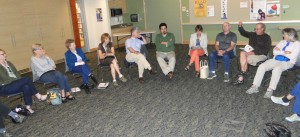ABC MEETING REPORT, July 24, 2014: ************************** A fun interactive evening was held, chaired by Kay Pullen. We started out with Bruce Hoeft asking us to all complete Surfrider’s online survey in an effort to make recreational uses of Washington’s shoreline an important ingredient in future decisions on land use of the coast. The website is: http://surfrider.org/washington-survey/ Then Jerry Broadus, well known as a bird bander, presented 2 long dark-colored feathers as a quiz and passed them around. It came as a surprise to many of us that they were from 2 different species when he finally revealed the answers. One of them was a primary from a Turkey Vulture, and the other, which was a dark primary with a white shaft, was from (surprise!) a Brown Pelican. Jerry mentioned that the only field guide that illustrated the white shaft was Sibley’s. I see that’s more obvious in the newer Sibley’s. Thanks, Jerry! Then on to the main discussion of the evening, a book discussion about migration centered around “Songbird Journeys” by Miyoko Chu. Kay Pullen led the discussion and started off with an excellent recorded interview with the author, which actually added to points made in the book. Our discussion centered around several points, especially how much was unknown about passerine migration until VERY recently and that much more remains to be learned. In a discussion centered on eBird now adding new insights to migration, Jerry brought up a recent ABA Birding magazine feature where an eastern hummingbird citizen science project that had been ongoing for many years clashed with eBird’s results, adding to the conclusion that so much is still to be learned. Faye and Clarice, as well as several others, noted that “our” birds who breed here are really visitors and are actually at “home” in the tropics where they spend more of their year. Discussion turned to experiments being done to figure out how birds know where to go, including clues from the stars, the earth’s magnetic field, and geographical landmarks. Vera had found a news video about an experiment on Euro Robins which disrupted migration when lots of human-sourced electronics were being used such as AM radio transmission. Wind farms and solar farms were mentioned as some of the many other hazards that have led to the huge downturn in numbers of migratory birds. Ken mentioned that by solar farm, he wasn’t referring to photovoltaics, but rather the ones where hundreds of mirrors follow the sun and condense the heat, thus making an invisible oven that any bird who happened by would be roasted in. Jerry mentioned visiting a bird market in Mexico no more than 5 years ago where thousands of birds, mostly passerines, were for sale in cages, long after this was supposedly outlawed there, and these were not parrots or the usual cage birds we think of, but our neotropic migrants for the most part. He said there was an entire floor dedicated to Jays. Then the difficulty of tracking migration was explored. Ms. Chu in her book had mentioned night flights, and Kay brought up the excellent website which uses radar to track, Birds Over Portland (which covers the entire northwest): http://birdsoverportland.wordpress.com/ Other methods of counting nighttime migrants include by voice, and Jim Danzenberger’s conversations with me about his data from his home in Battle Ground were mentioned with a handout passed around where he delineates his methods and the questions this has all raised in his mind. There was some discussion about getting him here next year some time to discuss this in person including his equipment, recorders, computer programs, etc. We’ll all be reading his Tweeters messages about his night censuses which will be starting up again in August. We had such a good time discussion this topic using a book as a starting point that we may do this again each summer. One book that was widely mentioned possibly for next year was “The Thing With Feathers,” by Noah Strycker. Read more about it here: http://www.amazon.com/Thing-Feathers-Surprising-Lives-Reveal/dp/1594486352/ref=sr_1_1?s=books&ie=UTF8&qid=1406316449&sr=1-1&keywords=the+thing+with+feathers Photo below of a few of the participants by Diane Y-Q (click to enlarge):



